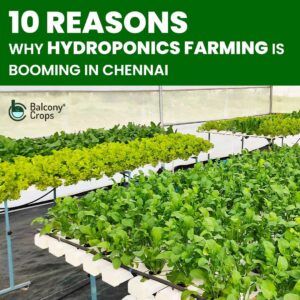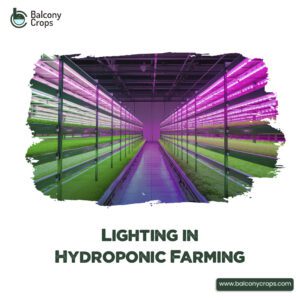Table of Contents
Table of Contents
Terrace gardening complements hydroponic farming by transforming rooftops and balconies into productive green spaces. By utilizing vertical space and innovative growing systems, we can enjoy fresh, homegrown produce year-round. These methods not only enhance food security but also promote environmental sustainability by reducing the need for long-distance food transportation.
What is a Green Shade Net?

Using a green shade net offers numerous advantages for both traditional and hydroponic farming, as well as terrace gardening. Here are some key benefits:
- Temperature Regulation: Green shade nets help maintain optimal temperature levels by filtering and diffusing sunlight. This is particularly beneficial in hot climates like Chennai, where excessive heat can stress plants and hinder their growth.
- UV Protection: These nets block harmful ultraviolet rays, which can damage plant tissues. By protecting plants from intense UV exposure, shade nets enhance plant health and ensure vigorous growth.
- Water Conservation: Shade nets reduce water evaporation from soil and growing media, helping conserve water. This is crucial for hydroponic systems and terrace gardens, where efficient water use is a priority.
- Pest and Bird Protection: The physical barrier provided by shade nets keeps pests and birds away from crops, reducing the risk of damage and disease transmission. This minimizes the need for chemical pesticides, promoting a more sustainable and eco-friendly farming practice.
- Enhanced Photosynthesis: By diffusing light, green shade nets ensure even light distribution across the plants, optimizing photosynthesis. This leads to better growth rates and higher yields.
- Extended Growing Seasons: Shade nets create a microclimate that protects plants from extreme weather conditions, enabling year-round cultivation. This is particularly advantageous for urban farmers in Chennai who face unpredictable weather patterns
Incorporating green shade nets into your hydroponic farm or terrace garden can significantly improve plant health, boost productivity, and contribute to sustainable urban agriculture.
Types of Shade Nets
Green Shade Nets :

Green shade nets come in various types, each designed to cater to different environmental conditions and agricultural needs. The primary distinction among these nets is their shading factor, which refers to the percentage of sunlight they can block:
- Light Shade Nets: Typically offer 30-50% shade. These are suitable for plants that require a lot of light but need protection against mild sunlight intensity.
- Medium Shade Nets: Provide 50-70% shade, ideal for more delicate plants that thrive under moderate light and require protection from strong sunlight.
- Heavy Shade Nets: These nets block 70-90% of sunlight, best for very sensitive plants or for use in areas with extremely high temperatures where significant shading is necessary to prevent plant stress.
White Shade Nets :
- Heat Reflection: White shade nets are excellent for reflecting heat, making them ideal for hot climates like Chennai. They help maintain a cooler environment for the plants by bouncing back a significant portion of sunlight.
- Light Diffusion: These nets diffuse light evenly, ensuring that all parts of the plant receive adequate sunlight. This uniform light distribution promotes balanced growth and reduces the risk of sunburn on plants.
- Optimal for Vegetables and Flowers: White nets are particularly beneficial for vegetables and flowering plants that thrive under moderate, diffused light conditions. They create a bright, airy environment conducive to healthy growth.
Black Shade Nets :
- Heat Absorption: Black shade nets absorb heat, which can help warm the plants in cooler environments. This characteristic makes them suitable for areas where temperatures drop significantly during certain seasons.
- UV Protection: These nets offer superior UV protection, shielding plants from harmful rays that can cause tissue damage. The high level of protection ensures the plants remain healthy and stress-free.
- Best for Hardy Plants: Black nets are ideal for hardy plants that can tolerate some heat but require protection from excessive sunlight. They create a more shaded, cooler environment, reducing water loss and stress.
Blue Shade Nets :
- Cooling Effect: Blue shade nets have a cooling effect, which makes them ideal for tropical climates. They help in reducing the ambient temperature around the plants, preventing heat stress.
- Improved Crop Quality: These nets are known to enhance certain crop qualities, such as color and size, by providing optimal growing conditions. They are particularly favored for specific crops like lettuce.
- Specific Applications: Blue nets are used in environments where precise light management is necessary to achieve the desired plant characteristics. They are popular in high-value crop cultivation.
By understanding the specific benefits of each color, you can choose the right shade net to create the perfect growing environment for your plants, ensuring optimal growth and productivity in any climate.
Installing a Green Shade Net on Your Terrace :
Installing a green shade net on your terrace can transform it into a functional and productive growing space. Here’s a step-by-step guide to ensure a successful installation:
- Measure Your Space: Begin by measuring the area of your terrace where you plan to install the shade net. This will determine the size of the net you need.
- Choose the Right Net: Select a shade net that best fits your climatic conditions and plant types. Consider the different shade percentages and material qualities to find one that suits your specific requirements.
- Secure the Fixtures: Purchase or prepare durable fixtures such as hooks, cables, or poles that can hold the net securely. These should be strong enough to withstand wind and weather changes.
- Attach the Net: Fasten the corners of the net to the fixtures, ensuring it is taut to avoid sagging. Use ties or clamps to secure the net at regular intervals along the fixtures, creating a stable, uniform cover over the area.
- Check for Gaps: Once installed, inspect around the edges and corners to make sure there are no gaps. All sides should be well-covered to provide maximum protection and efficiency.
- Maintenance: Regularly check the integrity of the net and its attachments. Replace any worn-out ties and adjust the tension as needed to keep the net in optimal condition.
By following these steps, you can effectively install a green shade net on your terrace, creating a protected environment that enhances plant growth and extends the growing season. This setup not only maximizes your terrace’s utility but also contributes to a sustainable urban gardening practice.
Maintenance and Care :
Regular maintenance is essential to ensure the longevity and effectiveness of your green shade net. Here are some detailed to guide you:
- Routine Checks: Regularly inspect your shade net for tears, holes, or any signs of wear and tear. Identifying issues early allows for prompt repairs, preventing further damage and ensuring continuous protection for your plants.
- Timely Repairs: When you find damaged sections, repair them immediately using UV-resistant thread or patch kits designed for shade nets. If the damage is extensive, replace the affected sections to maintain optimal coverage.
- Debris Removal: Periodically clean your shade net to remove leaves, dust, and other debris. Use a soft brush or low-pressure water spray to prevent buildup that can block sunlight and hinder proper airflow to your plants.
- Adapting to Weather Changes: Adjust the tension and position of the shade net according to seasonal weather changes. For instance, during windy seasons, ensure the net is securely fastened to prevent it from tearing or getting dislodged.
- Proper Storage: If you need to take down the shade net during certain times of the year, store it properly. Clean and dry the net before folding it neatly, and keep it in a dry, cool place to prevent mold and deterioration.
By following these maintenance tips, you can extend the lifespan of your green shade net and ensure it continues to provide effective protection and optimal growing conditions for your plants.
Case Studies: Success Stories from Terrace Gardens:
S.Rajash Kumar
I recently had the pleasure of working with Balcony Crops to set up a green shade net for my agricultural business. The entire process was smooth and professional from start to finish. The team was incredibly knowledgeable and provided excellent advice on the best type of netting to suit my needs. The installation was quick and efficient, and the quality of the materials used is top-notch.
Additionally, I was pleasantly surprised by the cost. Typically, this type of work is charged at around Rs100 per square foot, but Balcony Crops only charged me Rs 50 rupees per square foot. Since setting up the shade net, I’ve noticed a significant improvement in the growth and health of my plants.
One of the best features of this green shade is its removability. It’s not permanent, so I can use it during the summer and easily remove it in other sessions .This flexibility makes me feel that I selected the right company for the job.I highly recommend Balcony Crops to anyone looking to enhance their agricultural productivity with a green shade net. Their service is truly outstanding.
How Balconycrops Can Help You Get Started :
Balconycrops offers comprehensive support and expertise to kickstart your terrace gardening journey. From providing high-quality green shade nets and hydroponic farming sets to offering personalized consultation services, we guide you every step of the way.Our experienced team assists in selecting the right equipment, designing your garden layout, and optimizing plant care techniques. With Balcony Crops, you gain access to reliable resources and practical advice to create a flourishing terrace garden that suits your needs and preferences. Start your urban gardening adventure with confidence and let Balcony Crops be your trusted partner in cultivating green spaces in Chennai’s urban landscape.









